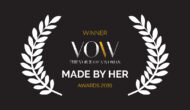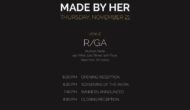GRACE JONES RECEIVES THE VOICE OF A WOMAN AWARD
THE VOICE OF A WOMAN presented the first screening of the film GRACE JONES: BLOODLIGHT AND BAMI in New York on November 4th 2017 to a full house left with standing room only, followed by an evening in conversation with Grace Jones. Grace Jones received THE VOICE OF A WOMAN LIFETIME ACHIEVEMENT AWARD for her career spanning more than 5 decades in film, fashion and music.
Grace Jones has played many parts over the course of her career, as May Day in the 1985 James Bond film "View to Kill" opposite Roger Moore (James Bond), as Zula opposite Arnold Schwarznegger in "Conan the Destroyer" and others; today she is revered as a pop-culture icon and inspiration to the likes of Rihanna, Lady Gaga and Beyonce as a woman who blazed a trail, living by her own rules and in so doing reaching iconic status in fashion, music and film - very few women of her era have been able to conquer all three industries with equal dominance. In the film Grace Jones: Bloodlight and Bami, Grace takes off the mask and submits herself to a truly intimate gaze as we experience Grace the daughter, mother, sister and even grandmother, allowing us to understand what lies at the root of the rebel who has pushed against all the boundaries set before her.
The stage is where Grace Jones’ most extreme embodiments are realised, where her theatrical imagination lets loose and the musical of her life is played out. The film includes unique performances of her iconic hits Slave To The Rhythm and Pull Up To The Bumper as well as more recent autobiographical tracks, Williams' Blood, This Is and Hurricane. These personal songs link to the film’s narrative that follows Grace on a holiday road trip across her native Jamaica, with her son Paulo and niece Chantal. Here the family’s roots and the story of her traumatic childhood are uncovered.
Through the film Grace and her brothers Chris and Noel, raised for several years by their violent, disciplinarian step grandfather Mas P, attempt to understand and exorcise this formative experience. Meanwhile the sensuality of the island and its tropical splendours resonate a pleasure principal that has equally shaped Grace Jones’ appetite for life.
In Jamaican patois, ‘Bloodlight’ is the red light that illuminates when an artist is recording and ‘Bami’ means bread, the substance of daily life. The film cuts between Jamaica and Jones’ public and professional life. Here we see her as a gypsy moving between Tokyo, Paris, Moscow, London and New York, an artist in the recording studio with Jamaican drum and bass duo Sly and Robbie (musical collaborators across her career) or recounting to some backstage groupies her infamous Russell Harty TV appearance, from her side of the story. Warm and funny, she is both Bacchus – the wild partying hedonist – and a fierce and tenacious businesswoman.
Her stage is the fixed point to which the film returns, with Love Is The Drug acting like an aria, bringing the film to its final and most touching scenes including an encounter with French photographer Jean Paul Goude, father of Jones’ son Paulo and creator of her iconic album covers. This is a Grace we have not seen before, someone who reminds us of what it is to dare to be truly alive. In all her apparent contradictions, Grace Jones may appear an exception, but she is also a point of identification: she is the exception that proves the rule.
A CONVERSATION WITH DIRECTOR SOPHIE FIENNES AND WRITER LEONIE GOMBRICH
There’s an enormous amount here for fans of Grace Jones to enjoy, but this film goes much further than that. It’s a very rich and textured portrait both of a performer and of a person. Can you tell us how it came about?
Grace and I originally met because I’d made a film about her older brother Noel’s church in Los Angeles (Hoover Street Revival, 2001) and she said, “You understand where I’m from.” She stood up at the end, clapping, and said, “I love the smell of your film”. Also, she felt that because I come from a big family, I knew something about the shared experience of siblings.
She was in the middle of making her album Hurricane, but we didn’t want the film to be just about that – we wanted to go further. I decided to be very open, just gather footage – gather evidence. When you make observational documentary, you’re completely at the mercy of life as it’s unfolding; you have control over nothing except your creative instinct. I had a bag packed and when she called, I’d just go – to Moscow, to the studio, to New York – as part of her entourage. She actively wanted to explore her relationship to Jamaica and as there was a family gathering there, she brought me along. I happened to be in Paris when she was doing the photo-shoot with Jean-Paul Goude and her grand daughter was born. I gathered material across five years, so I had an enormous amount. Then I began the process of sorting through it, working out what I could do, what the footage I had created could say about Grace.
The footage of Grace and her family in Jamaica acts as a core narrative: there’s clearly a story there that unfolds throughout the film.
There are four filmic layers and the Jamaican holiday road-trip is one. They are interwoven in such a way as to pull the viewer through. It’s like an onion skin: constructing those layers and how they work together is the work of making the film.
The film isn’t nostalgic, its not a bio-pic in the sense of telling the full story of her whole life in a piece-meal way. Grace’s past is always in her present anyway, but the Jamaican material takes us to her origins; the root and the soil which grew her, as much as the narrative of the childhood itself. As I gathered the material, I became fascinated by the contrast between what was natural, in terms of light, skin, sounds and colours and what was ‘anti-natural’, as the film simultaneously follows Grace into her professional and public life - so, the texture of the metropolis, painting her face, living in a series of presidential hotel suites, and her passage to and from the stage itself.
Her performance is powerfully captured with the luscious concert footage that punctuates the film. Watching it, it was a gradual realization that her songs are a commentary on her life – you’ve certainly used them in that way.
Grace sees herself as a storyteller so I approached the performance with that in mind; thinking about the songs as shaping the narrative. I made a rough edit of the documentary footage in advance so I had the best possible sense of what songs would link where, from the mesmerizing fury of Nipple to The Bottle, to her call to action to ‘party!’ that is Pull Up To The Bumper. Grace once said to me, “The music says more about me than I can say about the music.” I hope I managed to bring that sense into the film.
The staging gives Grace the space and freedom to move, and retains her aesthetic language: strong, graphic, elegant. She didn’t rehearse in the set. It’s like she says in the film: ”The performer out there takes the risk.” Her instinct in the live moment is key to how her performance happens, and it’s also in how she relates to her audience. Her performance has changed a lot since the One Man Show in the 1980s. She was much more distant then.
Grace feels powerful being naked; it’s not a point of fear or vulnerability for her. Jasper Conran worked with costumiers at The Royal Opera House to design a corset to give her this freedom to be in her own skin. There’s a quality of attack in how she moves, like a dancer, and it’s also informed by her modelling career. She’s animated by life and in this sense she is properly erotic. Then of course there are the Philip Treacy hats. We pulled this extraordinary wimple from his archives and she wears it when she sings Williams’ Blood; she’d worn that when she sang with Pavarotti.
I worked closely with Ivor Guest, who is the producer of Grace’s album Hurricane. Ivor appears in the film, and is the musical director, overseeing the recording and mixing of the live music. Ivor formed The Grace Jones Band, who have toured with her since 2008.
I worked again with cinematographer Remko Schnoor and we shot on Super 16 mm film. I had in mind the simplicity of those extraordinary sequences of Rita Hayworth in Gilda, where the camera plays in a subtle way with her performance, so you can read and follow what the body is doing. Film is such a sensual medium. I hope people see the film in the cinema, as it’s only there that the sound and picture can be fully experienced.
Even though the music’s incredibly important, she’s something other than a pop star, isn’t she? That’s not what defines her at all.
I see her as a performance artist. Outside of corporate gigs, for Grace, visual expression or making music is an art practice. That’s why she self-funded the album, Hurricane. As she says in the film, “We want the freedom to make the music we want to make.” It’s very personal. It’s like any artist – you’re out there,
fighting for your creative life. We see her do that. And we see the pleasure of her making the music, those creative moments when she’s with Ivor Guest and Sly & Robbie.
You’ve made a lot of films that seem to be about performance, or at least about performers. Was that part of what interested you about working with Grace?
Well, frankly Grace is just great fun to be with! She is extremely funny, and I really try to minimise the sense of my presence in the film, so as the viewer you get these two hours with her to yourself, as it were.
But performance is a central part of the person and the artist, Grace Jones, so to make a film that didn’t represent that would have been nonsense. I’m also interested in being as a daily performance. “Who do I need to be today, who do I feel myself to be?” is part of everyone’s life; it certainly is for women.
In this sense Grace is a wonderful subject. It would be a mistake to think of the “mask” with a fixed “self” behind that. We do see her constructing her stage persona: putting on the make-up, the painted mask, and becoming ‘Grace Jones’, but in nearly every documentary scene she’s also unconsciously experimenting with who or what she feels she is. People are immediately struck seeing the film by how she slips between accents: French, English, Jamaican, American or, in Japan, even speaking English with a Japanese accent.
I realised after cutting the film that she is naturally riffing on this question of identity almost all the time, beyond the androgyny she is famous for playing with. “Sometimes you have to be a high-flying bitch,” she says, or “I’m going tribal,” or “I’m human, man! I’m human!,” or “Oh the fucking panther is coming out in me now!” or “I feel like six years old!” or “I’m a Gypsy, please!” She might be a lascivious ‘Williams’, an entitled ‘Jones’ or the dominating ‘Mas P’.
I think it’s fascinating how she realized that she is unconsciously impersonating her scary, Jamaican stepfather, ‘Mas P’, in her stage persona; in this sense her performance is a transformational act. It’s a testament to the creative impulse; she’s not a victim and she is not afraid. She turned that fear around and put it out there, onto us!
Which brings us to another of the film’s layers: her international “gypsy” life. Her location changes almost as much as her identity. She’s so constantly on the move that you really can’t tell where her home is. If someone asked me where she lives, I’d have to say, “On the stage.”
That was deliberate. The stage is the anchor. There’s enough disassociation of place and time that the stage needs to be a physical place we return to, even if Grace’s performance there is shifting according to the songs.
Her international life, sipping Cristal champagne in a fur coat in Paris, is a striking contrast with her world in Jamaica, attending church with her mother or travelling with her brothers to Spanish Town, where they grew up.
For me, this is the beauty of ‘verite cinema’ – or ‘documentary cinema’. I am trying to find a term to define a new genre as it’s so frustrating today that everyone wants to approach films in terms of genres. So it’s not fiction but it’s not journalism either. It’s the richness of time and moment captured. These contrasts we travel through with Grace are simply the crazy contrasts of the world itself. In the edit I discovered I could play all kinds of games, moving between day and night and from place to place with Grace.
Yes, after wild, hedonistic partying in the far-out reaches of an urban night club, we wake up and go to church with Grace in Jamaica; what we see is that her mother is a performer, too – a church performer.
Yes, and we see Grace supporting her mother’s performance in church. Whether you’re religious or not, there is something very powerful that happens with her mother’s performance and Grace within it. For me, it’s because the song touches on the loss of intimacy with her parents in her childhood – this is a large part of the Jamaican story in the film. We see her mother singing jubilantly, ”God’s eye is on the sparrow, and I know He watches over you and me!”, but for Grace it was the eye of the mother that was not there for many precious years of her childhood.
An eye, a gaze, being seen, or simply looking and being looked at: this theme emerged in a powerful way from the documentary material. It’s central to cinema itself, which captures the visual world, but it’s also very personal and critical for Grace, I think. With my camera, I am that intimate gaze, but now I pass this over to each person who views the film.



